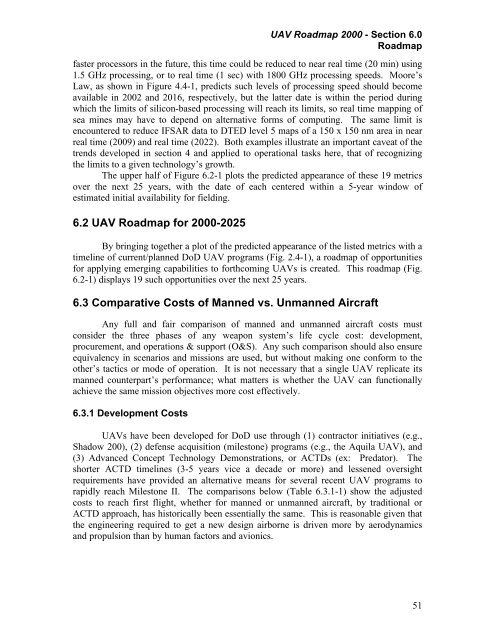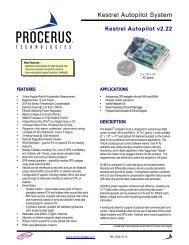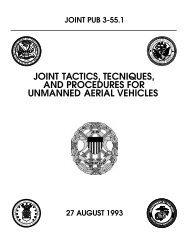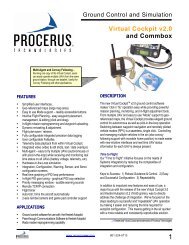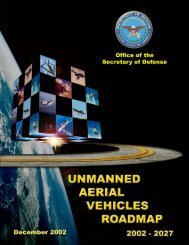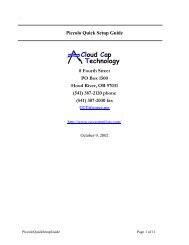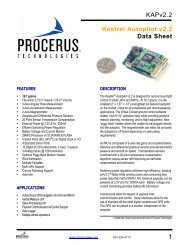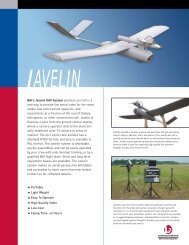<strong>UAV</strong> <strong>Roadmap</strong> 2000 - Section 6.0<strong>Roadmap</strong>endurance metrics seek to provide 20-, 30-, and 40-percent increases in flight enduranceby equivalent improvements in specific fuel consumption (SFC) for a given engine typeand constant fuel weight. Figure 4.1.2-1 predicts these increases should be attainable,due to such efforts as the AFRL’s Versatile, Affordable, Advanced Turbine Engine(VAATE) program, by 2005, 2010, and 2015 respectively. These percentages equate to20-, 30-, and 40-percent more time on station for the same number of deployed aircraftused today, helping address the coverage shortfall identified by the majority of theCINCs. The signature metric, driven by the CINCs’ priorities for enhancing forceprotection, is to provide a <strong>UAV</strong> that is inaudible from 1000 ft, and ideally from 500 ft,slant range to preclude detection by base intruders. Figure 4.1.2-2 anticipates the massspecific power of fuel cell-powered engines will equal or exceed that of noisy internalcombustion engines by 2004, enabling their use in fielding a silent airborne sentry.To illustrate future payload opportunities, resolution metrics for EO/IR sensorsand SARs were developed. Based on a recurring scenario in many theaters—an embassyor non-combatant evacuation from a foreign city—CINCs need a standoff sensor to avoidboth further inciting the local populace and/or being downed by MANPADs (e.g., SA-7/14) with maximum ranges of up to 4 nm. Such sensors should be capable ofdistinguishing armed from unarmed persons, and, ideally, identifying specificindividuals. The former capability requires video imagery with a GRD of 4-8 in, NIIRS8, and an instantaneous field of view of 0.014 mrad; the latter requires a 2-4 in GRD,NIIRS 9, and a 0.007 mrad IFOV. Figure 4.2.2-1 predicts that improved focal planearrays could enable today’s gimbaled EO/IR sensor turrets to reach these levels ofresolution by 2002 and 2005, respectively. For area searches, today’s best SARs canimage the equivalent of a 10 nm wide swath at 12 in resolution. The metrics chosen areto halve this resolution (6 in), then halve it again (3 in) for the same swath width, then todouble the swath width covered to 20 nm and again achieve 6 and 3 in resolution. Figure4.2.2-2 forecasts these capabilities being fielded by 2001 (6 in), and 2005 (3 in) for 10nm wide swaths, and by 2010 (3 in) for 20 nm wide swaths.Advances in <strong>UAV</strong> data links were measured in terms of data rate-based metricsneeded for relaying unprocessed SIGINT and uncompressed multi-spectral imagery inreal time. Such capabilities would contribute strongly to ensuring CINCs receive ISRinformation inside their opponents’ decision cycles. For SIGINT, the capability to relaythe entire COMINT spectrum or the entire ELINT spectrum was chosen. Figure 4.3-2forecasts the communications technology for these opportunities could be fielded by2005 and 2025+, respectively. For IMINT, the ability to relay successive 10-band multispectral(MSI) at 0.16 Gb/image, 100-band hyper-spectral (HSI) at 1.6 Gb, and 1000-band ultra-spectral imagery (USI) at 16 Gb, all at 1 sec intervals was chosen. Theselevels should be reached by 2000, 2010, and 2025+, respectively. Of course any decisionto increase reliance on lasercoms would potentially allow the necessary data rates to beachieved sooner.Finally, metrics were developed for information processing based on CINCprioritization of, and emerging technology in, counter mine warfare. The technology isthat of ONR’s Airborne Remote Optical Spotlight System (AROSS), which currentlyemploys 500 MHz processing over 48 hrs to extract images of broaching sea mines fromPredator <strong>UAV</strong> Skyball video. After optimizing AROSS’ software, this process will stillrequire an hour between imaging and results being available for dissemination. Using50
<strong>UAV</strong> <strong>Roadmap</strong> 2000 - Section 6.0<strong>Roadmap</strong>faster processors in the future, this time could be reduced to near real time (20 min) using1.5 GHz processing, or to real time (1 sec) with 1800 GHz processing speeds. Moore’sLaw, as shown in Figure 4.4-1, predicts such levels of processing speed should becomeavailable in 2002 and 2016, respectively, but the latter date is within the period duringwhich the limits of silicon-based processing will reach its limits, so real time mapping ofsea mines may have to depend on alternative forms of computing. The same limit isencountered to reduce IFSAR data to DTED level 5 maps of a 150 x 150 nm area in nearreal time (2009) and real time (2022). Both examples illustrate an important caveat of thetrends developed in section 4 and applied to operational tasks here, that of recognizingthe limits to a given technology’s growth.The upper half of Figure 6.2-1 plots the predicted appearance of these 19 metricsover the next 25 years, with the date of each centered within a 5-year window ofestimated initial availability for fielding.6.2 <strong>UAV</strong> <strong>Roadmap</strong> for 2000-2025By bringing together a plot of the predicted appearance of the listed metrics with atimeline of current/planned DoD <strong>UAV</strong> programs (Fig. 2.4-1), a roadmap of opportunitiesfor applying emerging capabilities to forthcoming <strong>UAV</strong>s is created. This roadmap (Fig.6.2-1) displays 19 such opportunities over the next 25 years.6.3 Comparative Costs of Manned vs. <strong>Unmanned</strong> <strong>Aircraft</strong>Any full and fair comparison of manned and unmanned aircraft costs mustconsider the three phases of any weapon system’s life cycle cost: development,procurement, and operations & support (O&S). Any such comparison should also ensureequivalency in scenarios and missions are used, but without making one conform to theother’s tactics or mode of operation. It is not necessary that a single <strong>UAV</strong> replicate itsmanned counterpart’s performance; what matters is whether the <strong>UAV</strong> can functionallyachieve the same mission objectives more cost effectively.6.3.1 Development Costs<strong>UAV</strong>s have been developed for DoD use through (1) contractor initiatives (e.g.,Shadow 200), (2) defense acquisition (milestone) programs (e.g., the Aquila <strong>UAV</strong>), and(3) Advanced Concept Technology Demonstrations, or ACTDs (ex: Predator). Theshorter ACTD timelines (3-5 years vice a decade or more) and lessened oversightrequirements have provided an alternative means for several recent <strong>UAV</strong> programs torapidly reach Milestone II. The comparisons below (Table 6.3.1-1) show the adjustedcosts to reach first flight, whether for manned or unmanned aircraft, by traditional orACTD approach, has historically been essentially the same. This is reasonable given thatthe engineering required to get a new design airborne is driven more by aerodynamicsand propulsion than by human factors and avionics.51


